

Compact Muon Solenoid
LHC, CERN
| CMS-PAS-HIN-18-011 | ||
| Angular correlations in exclusive dijet photoproduction in ultra-peripheral PbPb collisions at √sNN= 5.02 TeV | ||
| CMS Collaboration | ||
| July 2020 | ||
| Abstract: Exclusive dijet photoproduction has been measured in ultra-peripheral lead-lead (PbPb) collisions at √sNN= 5.02 TeV. The analysis is based on a data sample corresponding to an integrated luminosity of 0.38 nb−1 collected by the CMS Collaboration. For each dijet, the transverse momentum vectors of the leading and subleading jets are measured and their vector sum and vector difference determined. The azimuthal angle between the vector sum and vector difference defines an angle ϕ. The distribution of ϕ and, in particular, the second Fourier harmonic <cos(2ϕ)> is measured. The dependence of <cos(2ϕ)> on the sum of the jet momentum vectors provides the first azimuthal anisotropy measurement related to exclusive dijet production. | ||
|
Links:
CDS record (PDF) ;
inSPIRE record ;
CADI line (restricted) ;
These preliminary results are superseded in this paper, Submitted to PRL. |
||
| Figures | |

png pdf |
Figure 1:
Distributions of the maximum distance in pseudorapidity between the most backward jet and a track in an event (left) and the backward rapidity gap (right) shown for data and reconstructed RAPGAP MC (see text for details). |
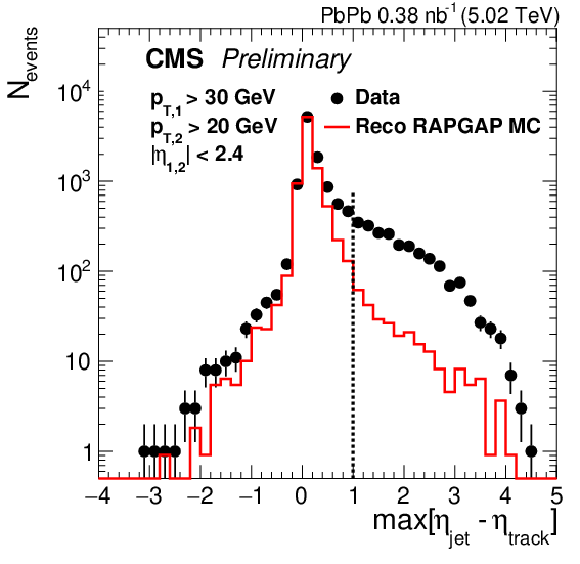
png pdf |
Figure 1-a:
Distribution of |
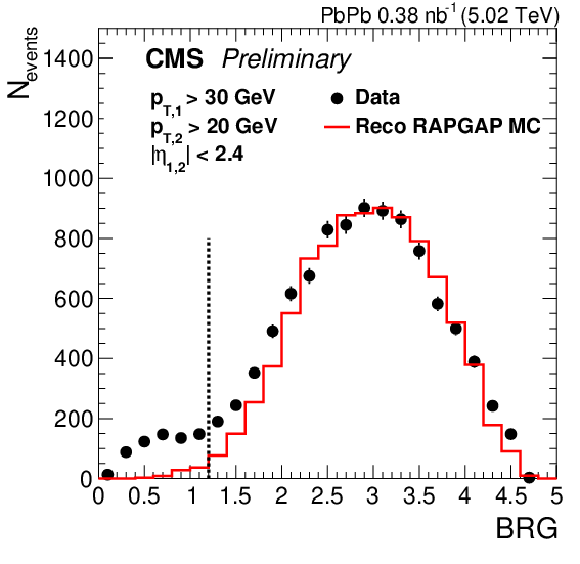
png pdf |
Figure 1-b:
Distribution of the backward rapidity gap shown for data and reconstructed RAPGAP MC (see text for details). |
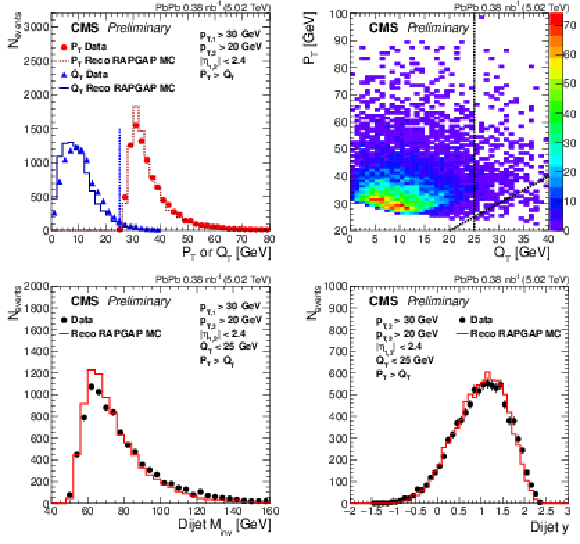
png pdf |
Figure 2:
Magnitudes of the vector sum (QT) and vector difference (PT) of the two jets (top left) and their correlation (top right) for the events that pass the selection criteria. The diagonal line illustrates the PT>QT requirement. Invariant mass (bottom left) and rapidity (bottom right) of the dijet candidates after further QT and PT requirements. The lines show the prediction of the RAPGAP MC. |

png pdf |
Figure 2-a:
Magnitudes of the vector sum (QT) and vector difference (PT) of the two jets. The lines show the prediction of the RAPGAP MC. |

png pdf |
Figure 2-b:
Correlation of the vector sum (QT) and vector difference (PT) of the two jets for the events that pass the selection criteria. The diagonal line illustrates the PT>QT requirement. |

png pdf |
Figure 2-c:
Invariant mass of the dijet candidates after further QT and PT requirements. The lines show the prediction of the RAPGAP MC. |
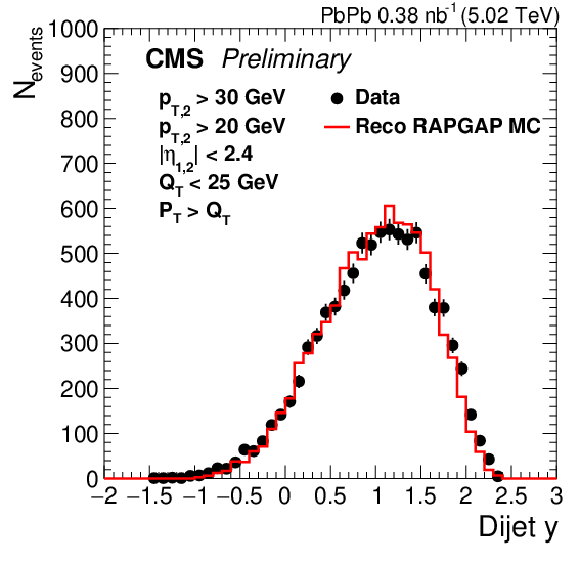
png pdf |
Figure 2-d:
Rapidity of the dijet candidates after further QT and PT requirements. The lines show the prediction of the RAPGAP MC. |
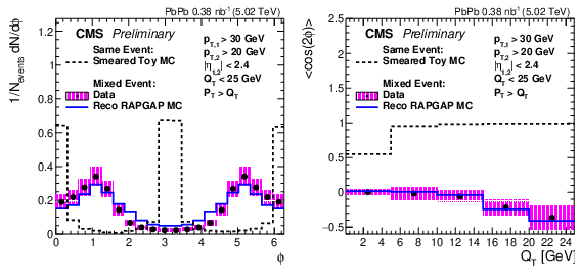
png pdf |
Figure 3:
The mixed event distributions obtained from data and compared to the RAPGAP prediction after full simulation and reconstruction (blue line). The left panel shows the ϕ distribution while the right panel shows the second harmonic of this distribution as a function of QT. Both the statistical (error bars) and systematic (magenta boxes) uncertainties are shown. Dashed histograms show the toy-MC distribution including the effect of detector smearing (see text for details). |
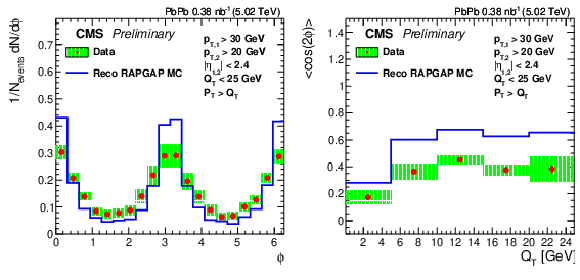
png pdf |
Figure 4:
The left panel shows the ϕ distribution while the right panel shows the second harmonic of this distribution for the data, as a function of QT. The corresponding distributions from RAPGAP after full simulation and reconstruction are also shown (blue lines). Both the statistical (error bars) and systematic (green boxes) uncertainties are shown. |
| Tables | |

png pdf |
Table 1:
<cos(2ϕ)> systematic uncertainties. |
| Summary |
| In summary, for the first time, angular correlations present in exclusive dijet photoproduction have been studied using ultra-peripheral lead-lead collisions at √sNN= 5.02 TeV. The second moment of the angular distribution, <cos(2ϕ)>, where ϕ is the angle between the vector sum and vector difference of the leading and subleading jet transverse momenta, has been measured as a function of the momentum sum of the two jets. This analysis amounts to the first, yet essential, step towards the extraction of the Wigner or Husimi gluon distributions, which are believed to be the most fundamental gluon distributions. It also introduces new techniques for the analysis of jet angular correlations in exclusive dijet events at colliders. |
| References | ||||
| 1 | A. J. Baltz et al. | The physics of ultraperipheral collisions at the LHC | PR 458 (2008) 1 | 0706.3356 |
| 2 | J. G. Contreras and J. D. Tapia Takaki | Ultra-peripheral heavy-ion collisions at the LHC | Int. J. Mod. Phys. A 30 (2015) 1542012 | |
| 3 | CMS Collaboration | Coherent J/ψ photoproduction in ultra-peripheral PbPb collisions at √sNN= 2.76 TeV with the CMS experiment | PLB 772 (2017) 489 | CMS-HIN-12-009 1605.06966 |
| 4 | CMS Collaboration | Evidence for light-by-light scattering and searches for axion-like particles in ultraperipheral PbPb collisions at √sNN= 5.02 TeV | PLB 797 (2019) 134826 | CMS-FSQ-16-012 1810.04602 |
| 5 | CMS Collaboration | Measurement of exclusive ρ(770)0 photoproduction in ultraperipheral pPb collisions at √sNN= 5.02 TeV | EPJC 79 (2019) 702 | CMS-FSQ-16-007 1902.01339 |
| 6 | CMS Collaboration | Measurement of exclusive Υ photoproduction from protons in pPb collisions at √sNN= 5.02 TeV | EPJC 79 (2019) 277 | CMS-FSQ-13-009 1809.11080 |
| 7 | ALICE Collaboration | Coherent J/ψ photoproduction in ultra-peripheral Pb-Pb collisions at √sNN= 2.76 TeV | PLB 718 (2013) 1273 | 1209.3715 |
| 8 | ALICE Collaboration | Charmonium and e+e− pair photoproduction at mid-rapidity in ultra-peripheral Pb-Pb collisions at √sNN= 2.76 TeV | EPJC 73 (2013) 2617 | 1305.1467 |
| 9 | ALICE Collaboration | Exclusive J/ψ photoproduction off protons in ultra-peripheral p-Pb collisions at √sNN= 5.02 TeV | PRL 113 (2014) 232504 | 1406.7819 |
| 10 | ALICE Collaboration | Coherent ψ(2S) photo-production in ultra-peripheral Pb Pb collisions at √sNN= 2.76 TeV | PLB 751 (2015) 358 | 1508.05076 |
| 11 | ALICE Collaboration | Coherent ρ0 photoproduction in ultra-peripheral Pb-Pb collisions at √sNN= 2.76 TeV | JHEP 09 (2015) 095 | 1503.09177 |
| 12 | ALICE Collaboration | Coherent J/ψ photoproduction at forward rapidity in ultra-peripheral Pb-Pb collisions at √sNN= 5.02 TeV | PLB 798 (2019) 134926 | 1904.06272 |
| 13 | ALICE Collaboration | Energy dependence of exclusive J/ψ photoproduction off protons in ultra-peripheral p--Pb collisions at √sNN= 5.02 TeV | EPJC 79 (2019) 402 | 1809.03235 |
| 14 | ATLAS Collaboration | Evidence for light-by-light scattering in heavy-ion collisions with the ATLAS detector at the LHC | NP 13 (2017) 852 | 1702.01625 |
| 15 | ATLAS Collaboration | Observation of light-by-light scattering in ultraperipheral Pb+Pb collisions with the ATLAS detector | PRL 123 (2019) 052001 | 1904.03536 |
| 16 | M. Strikman, R. Vogt, and S. N. White | Probing small x parton densities in ultraperipheral AA and pA collisions at the LHC | PRL 96 (2006) 082001 | hep-ph/0508296 |
| 17 | V. Guzey and M. Klasen | Diffractive dijet photoproduction in ultraperipheral collisions at the LHC in next-to-leading order QCD | JHEP 04 (2016) 158 | 1603.06055 |
| 18 | P. Kotko et al. | Estimating nonlinear effects in forward dijet production in ultra-peripheral heavy ion collisions at the LHC | EPJC 77 (2017) 353 | 1702.03063 |
| 19 | T. Altinoluk, N. Armesto, G. Beuf, and A. H. Rezaeian | Diffractive dijet production in deep inelastic scattering and photon-hadron collisions in the color glass condensate | PLB 758 (2016) 373 | 1511.07452 |
| 20 | Y. Hagiwara et al. | Accessing the gluon Wigner distribution in ultraperipheral pA collisions | PRD 96 (2017) 034009 | 1706.01765 |
| 21 | H. Mantysaari, N. Mueller, and B. Schenke | Diffractive dijet production and Wigner distributions from the color glass condensate | PRD 99 (2019) 074004 | 1902.05087 |
| 22 | Y. Hatta, B.-W. Xiao, and F. Yuan | Probing the small- x gluon tomography in correlated hard diffractive dijet production in deep inelastic scattering | PRL 116 (2016) 202301 | 1601.01585 |
| 23 | Y. Hatta, B.-W. Xiao, and F. Yuan | Gluon tomography from deeply virtual compton scattering at Small-x | PRD 95 (2017) 114026 | 1703.02085 |
| 24 | A. Dumitru, V. Skokov, and T. Ullrich | Measuring the Weizsacker-Williams distribution of linearly polarized gluons at an electron-ion collider through dijet azimuthal asymmetries | PRC 99 (2019) 015204 | 1809.02615 |
| 25 | Y. Hagiwara, Y. Hatta, and T. Ueda | Wigner, Husimi, and generalized transverse momentum dependent distributions in the color glass condensate | PRD 94 (2016) 094036 | 1609.05773 |
| 26 | Y. Hagiwara, Y. Hatta, B.-W. Xiao, and F. Yuan | Elliptic flow in small systems due to elliptic gluon distributions? | PLB 771 (2017) 374 | 1701.04254 |
| 27 | J. Zhou | Elliptic gluon generalized transverse-momentum-dependent distribution inside a large nucleus | PRD 94 (2016) 114017 | 1611.02397 |
| 28 | CDF Collaboration | Observation of exclusive dijet production at the Fermilab Tevatron p−ˉp collider | PRD 77 (2008) 052004 | 0712.0604 |
| 29 | ZEUS Collaboration | Production of exclusive dijets in diffractive deep inelastic scattering at HERA | EPJC 76 (2016) 16 | 1505.05783 |
| 30 | S. R. Klein and H. Mantysaari | Imaging the nucleus with high-energy photons | Nature Rev. Phys. 1 (2019) 662 | 1910.10858 |
| 31 | W. Busza, K. Rajagopal, and W. van der Schee | Heavy ion collisions: the big picture, and the big questions | Ann. Rev. Nucl. Part. Sci. 68 (2018) 339 | 1802.04801 |
| 32 | U. Heinz and R. Snellings | Collective flow and viscosity in relativistic heavy-ion collisions | Ann. Rev. Nucl. Part. Sci. 63 (2013) 123 | 1301.2826 |
| 33 | CMS Collaboration | The CMS experiment at the CERN LHC | JINST 3 (2008) S08004 | CMS-00-001 |
| 34 | H. Jung | Hard diffractive scattering in high-energy e p collisions and the Monte Carlo generator RAPGAP | CPC 86 (1995) 147 | |
| 35 | F. D. Aaron et al. | Measurement of the cross section for diffractive deep-inelastic scattering with a leading proton at HERA | EPJC 71 (2011) 1578 | 1010.1476 |
| 36 | H1 Collaboration | Diffractive dijet photoproduction in ep collisions at HERA | EPJC 70 (2010) 15 | 1006.0946 |
| 37 | S. R. Klein et al. | STARlight: A Monte Carlo simulation program for ultra-peripheral collisions of relativistic ions | CPC 212 (2017) 258 | 1607.03838 |
| 38 | GEANT4 Collaboration | GEANT4: A Simulation toolkit | NIMA 506 (2003) 250 | |
| 39 | CMS Collaboration | Particle-flow reconstruction and global event description with the CMS detector | JINST 12 (2017) P10003 | CMS-PRF-14-001 1706.04965 |
| 40 | M. Cacciari, G. P. Salam, and G. Soyez | The anti-kt jet clustering algorithm | JHEP 04 (2008) 063 | 0802.1189 |
| 41 | M. Cacciari, G. P. Salam, and G. Soyez | FastJet User Manual | EPJC 72 (2012) 1896 | 1111.6097 |
| 42 | CMS Collaboration | CMS tracking performance results from early LHC operation | EPJC 70 (2010) 1165 | CMS-TRK-10-001 1007.1988 |
| 43 | CMS Collaboration | Jet energy scale and resolution in the CMS experiment in pp collisions at 8 TeV | JINST 12 (2017) P02014 | CMS-JME-13-004 1607.03663 |
| 44 | CMS Collaboration | Constraining gluon distributions in nuclei using dijets in proton-proton and proton-lead collisions at √sNN= 5.02 TeV | PRL 121 (2018) 062002 | CMS-HIN-16-003 1805.04736 |
| 45 | CMS Collaboration | Observation of long-range near-side angular correlations in proton-proton collisions at the LHC | JHEP 09 (2010) 091 | CMS-QCD-10-002 1009.4122 |

|
Compact Muon Solenoid LHC, CERN |

|

|

|

|

|

|